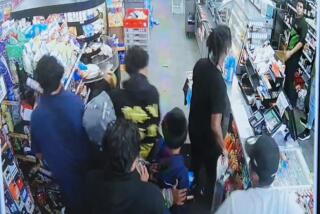7 Arrested in $100,000 Freeway Tagging Spree
Police on Tuesday arrested seven men and boys for allegedly spray-painting 14 miles of the Long Beach Freeway, a massive tagging spree that resulted in more than $100,000 in damage and is regarded as one of the worst concentrated graffiti attacks in Southern California’s history.
More than 25,000 graffiti attacks were made between May 13 and May 18 in a tagging war between rival area gangs.
The graffiti, which ran on the southbound freeway between the Broadway exit and the interchange with the Artesia Freeway, covered the freeways themselves, on-ramps, off-ramps and overpasses.
“You could not believe it,” Long Beach police spokeswoman Margarita DeWitt said.
In an early-morning sweep of several cities, police officers from a multi-agency task force arrested Marco Ross of Whittier and John Ehredt of La Mirada, both 18. They also took into custody five juveniles whose names were not released because of their ages, DeWitt said.
The suspects were booked on felony charges of vandalism and conspiring to commit vandalism.
A task force of more than 40 officers from the California Highway Patrol, the Long Beach Police Department and the Los Angeles County Sheriff’s Department handled the investigation, described as the first phase of a campaign against graffiti vandalism.
DeWitt said police are considering asking judges to impose sentences that include suspending the suspects’ driver’s licenses until they turn 21.
The adults face a maximum of a year in prison and $50,000 in fines, Long Beach city prosecutor John A. Vander Lands said.
DeWitt said Long Beach police are trying to hit taggers hard because “they’re damaging our city. We don’t have a very high tolerance for that.”
However, people who work in some of the buildings that border the Long Beach Freeway despaired of taggers ever being brought under control.
“It’s an ongoing battle,” said Pat McGurk, director of operations for International Containment Service, which has a warehouse near the freeway’s Del Amo exit and was hit in the tagging spree.
Making a few arrests “is like throwing a bucket of water on a forest fire . . . but the police are doing what they can,” said McGurk, who added that his company has spent thousands of dollars to graffiti-proof and repaint its walls.
McGurk says the graffiti gives potential customers a bad impression.
“If they come in and you’ve got a building that looks like it’s been in a war zone, they don’t want to do their business here,” he said.
Mike Humphreys, a worker at Everyday Products on Susanna Street, said that when new freight trains come in to drop off raw materials at his warehouse they wind up covered with graffiti.
Some of the tagging, Humphreys said, “is pretty artistic.” He said he wishes taggers “would go take some art school classes or something” rather than spray-painting.
One Los Angeles anti-graffiti activist, Joe Connolly, argued Tuesday that arresting taggers perpetuates the problem.
“Attention is what they want,” Connolly said. After the names of the taggers arrested Tuesday appear in the media, “20 of (their) buddies are going to go out and do everything in sight. . . . You can only beat them (taggers) with paint.”
Many of the businesses along the Long Beach Freeway paint over graffiti, saying they are discouraging taggers by erasing their work.
Long Beach police spokeswoman DeWitt said the department usually does not publicize tagger arrests, but wanted to make a point out of Tuesday’s action.
Mike Falenchik, a worker for Specialty Tabletops, a tableware manufacturer with offices along the freeway, paints over graffiti on the property. He said he found 27 empty spray cans behind the building after last month’s tagging spree. “I couldn’t believe how much was on there,” he said.
More to Read
Sign up for Essential California
The most important California stories and recommendations in your inbox every morning.
You may occasionally receive promotional content from the Los Angeles Times.









